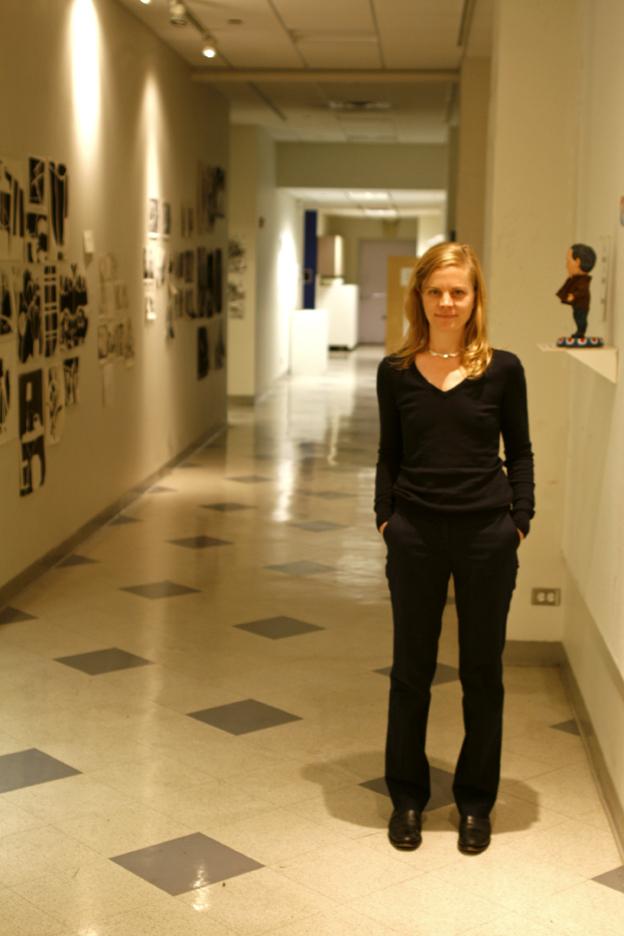Casey Ruble On Creating Moments of Suspension
Q&A with FCLC Artist-in-Residence and Professor Casey Rubel
June 16, 2011
Published: November 13, 2008
Artist-in-residence Casey Ruble teaches Drawing I and Senior Seminar at Fordham College at Lincoln Center. Outside of the university, her work has been shown both nationally and abroad. Her first solo exhibition, titled “Except in Struggle,” is being featured at the Foley Gallery, located at 547 W 27th St., from Oct. 14 to Nov. 15. Recently, The Observer spoke with Ruble about her art, teaching and her current exhibition.

OBSERVER: How and when did you first discover art was something you were interested in?
Casey Ruble: I knew from the time I was very young—I started drawing as soon as I could hold a pencil in my hand. As a child I would get up very early in the morning and make illustrated “books” and board games. I was never as interested in reading the books or playing the games afterward as I was in making new books and games! I was very single-minded about the whole thing, and in that way, I think I do fit into the stereotype of the “artist.”
Observer: What was it like growing up in Billings, Mont.? In what ways did it influence your art?
CR: I grew up on a ranch riding dressage with my mom and bird hunting with my dad. Dressage is a form of horseback riding that derives from cavalry movements but now is used to keep the horse limber and fit. It’s aesthetically beautiful—it looks like “horse ballet.” I think both of those childhood experiences have influenced my work—the hunt and the idea of a set of movements that are both militaristic and beautiful.
Observer: Who were your early inspirations?
CR: My parents were, and still are, a major support for me. My mom was not the typical mom who praises everything her child makes and immediately hangs it on the refrigerator. I’d show her a drawing I’d been working on all afternoon, and she’d look at it and say, “Well, this part is good, but you need to work more on getting that horse’s leg right.” Frustrated, I’d go back and work on the drawing again until I got it right.
Observer: How do you think that affected your work?
CR: One of the hardest things about being in the art world is that you open yourself up to a lot of criticism and rejection—you have to have a very thick skin and not take things personally. I think that my mom really helped me learn how to stay motivated even in the face of difficulty.
Observer: How has your art progressed over the years, especially during those you spent at Smith and Hunter Colleges?
CR: Before I got to New York, my “art” was pretty all over the place. I was always making stuff—drawing or painting or taking photographs—but I didn’t really have much focus. During grad school at Hunter, I began to understand the importance of committing to a certain set of issues or line of investigation—I began to understand the difference between being an artist and just being creative. This helped me narrow my focus in my art.
Observer: What are some key themes featured throughout your work?
CR: Conflict is really the overriding theme, and this comes out both in my choice of subject matter and in my use of the medium of paint. My main goal is to create tension and dissonance, but also harmony and balance—all of these are important components of battle. I try to make paintings that embody a moment of suspension, where you wonder whether everything is about to fall together or fall apart.
Observer: Is there any piece which you think best exemplifies that theme?
CR: “Dark Crescent.” It’s currently in my show at Foley. It’s of a mass of black horses with dark costumes battling within a large bramble of leafless twigs that sweeps down almost like a mass of hair. Bright red cardinals fly throughout the composition. Because all of the horses and costuming is dark, it’s hard to make out where one horse ends and another begins, and all of them are hopelessly tangled in the environment. It’s probably the most visually confusing painting I’ve made, which is why I like it.
Observer: Can you tell us a little bit about your current exhibition, “Except in Struggle”?
CR: The show includes three large battle scenes—all around 8 by 6 feet—and three mid-sized battle scenes. There are also three abstract paintings based on Japanese crests, which historically were used to identify opposing factions on the battlefield. I like exhibitions that include a couple of different bodies of work, because each informs the other and provides a slightly different way of looking at similar ideas or themes.
Observer: Many artists/teachers struggle with the demands of focusing on their art while teaching. Do you find this to be true in your case?
CR: Not at all. I’m often inspired by my students, and I’m energized after teaching a class. It’s not that students directly give me ideas about my own work, but they do keep me thinking about the greater dialogue that art participates in. Trying to understand the differences in the ways we see the world—and speculating on why those differences exist—helps broaden your perspective, which I think is essential in keeping your studio practice fresh.
Observer: Do you have any advice for aspiring artists at Fordham?
CR: Take advantage of the connections you make at Fordham and to stay in touch with your peers and professors after you graduate. Every opportunity I’ve been fortunate enough to have had—my paintings in shows, my exhibition at Foley, my job at Fordham—came thanks to other people I know recommending me. And it’s been through discussion with a small group of people whose opinions I respect that my art has continued to develop in ways that feel right for me.









